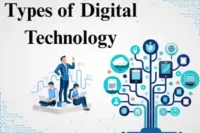What is Technology Management? Definition, Importance & Future Trends
Published: 12/Oct/2025
In our modern world, technology isn’t just part of business — it’s the backbone of it. From AI to automation, every organization depends on it to stay efficient and competitive. But using technology well requires more than tools — it needs strategy.
That’s where technology management comes in. It connects new ideas with company goals, people, and their performance. Whether you’re a student, professional, or entrepreneur, understanding it is key to success in the digital age.
In this guide, we’ll cover what is technology management, why it’s important, and how it drives business growth through innovation and real-world applications. So, let’s get started.
What Is Technology Management?
Technology management is the process of planning, developing, implementing, and maintaining technology resources to achieve business goals. It combines the principles of business strategy, innovation, and information systems to ensure that technology investments lead to real value.

In simple terms, technology management is about using technology to solve problems, improve efficiency, and create opportunities. It involves managing both the hardware (machines, devices, systems) and the software (processes, applications, human skills) that power modern organizations.
For example, a retail company may use technology management to optimize inventory systems, improve customer service, and reduce costs through automation. A hospital may use it to integrate AI diagnostics or telehealth systems. Every industry needs it in some way.
Why Technology Management Is Important
Technology is growing faster than ever before. Without proper management, even the most advanced businesses can quickly fall behind. Investing in new systems without a clear strategy often leads to wasted resources and confusion.
That’s why technology management is essential. It ensures that:
- Every tech decision aligns with the company’s broader goals.
- Teams are equipped and trained to use new tools effectively.
- Data remains secure, organized, and accessible.
- Innovation stays consistent with changing market needs.
In short, it helps companies work smarter, not harder. The goal isn’t just to adopt new tools—it’s to build a strategy that connects people, processes, and technology in a meaningful way.
Core Functions of Technology Management
Technology management isn’t a single task—it’s a set of interconnected functions that work together to drive progress. Here are the six main pillars:
1. Technology Planning
Setting long-term and short-term technology goals based on business needs. This involves budgeting, risk assessment, and selecting the right technology tools.
2. Research and Development (R&D)
Focusing on creating or improving products and services. R&D ensures that the organization stays competitive and relevant.
3. Implementation and Integration
Applying new technology to existing systems and ensuring it works smoothly with current processes.
4. Monitoring and Evaluation
Continuously checking how well technology performs and identifying areas for improvement.
5. Security and Risk Management
Protecting data, preventing cyberattacks, and ensuring systems follow security regulations.
6. Sustainability and Lifecycle Management
To ensure long-term durability, manage technology upgrades, maintenance, and disposal responsibly.
These functions work together to make sure that technology adds value rather than complexity.
Benefits of Technology Management
Technology management offers several benefits to today’s organizations. Here are its main advantages:
|
Challenges in Technology Management
While technology management offers many benefits, it also comes with a few challenges that organizations need to handle carefully. Here are the main ones:
|
Applications of Technology Management in Different Sectors
Technology management plays a vital role across almost every industry today. It helps organizations use technology more effectively, improve processes, and stay ahead of the competition. Here’s how it applies in different sectors:
1. Healthcare Sector
In healthcare, technology management ensures that hospitals and clinics use the right digital systems to deliver safe, efficient, and better patient care.
Applications:
- Managing Electronic Health Records (EHRs) and telemedicine platforms
- Integrating AI and machine learning for early diagnosis
- Overseeing medical device innovation and maintenance
- Keeping patient data safe and following privacy rules
- Making billing, scheduling, and reports faster and easier.
2. Business & Corporate Sector
In business environments, technology management aligns IT and digital strategies with overall business goals.
Applications:
- Implementing Enterprise Resource Planning (ERP) and Customer Relationship Management (CRM) systems
- Managing data analytics for informed decision-making
- Leading digital transformation projects
- Ensuring cybersecurity and data governance
- Automating operations through AI-powered tools
3. Education Sector
Educational institutions rely on technology management to enhance learning outcomes and administrative efficiency.
Applications:
- Managing Learning Management Systems (LMS) like Moodle or Canvas
- Integrating AI-based adaptive learning tools
- Overseeing digital classrooms and online learning platforms
- Securing student data and online resources
- Driving research through digital collaboration tools
You May Also Like This Post
➡️ What Is the Impact of Technology on Education Today?
4. Manufacturing & Industrial Sector
Manufacturing companies use technology management to implement automation, improve product quality, and optimize production costs.
Applications:
- Integrating Industrial Internet of Things (IIoT) for smart factories
- Managing robotics and automation systems
- Ensuring predictive maintenance using AI and sensors
- Overseeing supply chain digitization
- Implementing Green Technology for Sustainability
Future Trends in Technology Management
As technology evolves, businesses must adapt to stay ahead. Here are key trends shaping the future of technology management:
- Artificial Intelligence (AI): AI will automate routine tasks, analyze big data, and help managers make faster, smarter decisions.
- Cloud Computing: More businesses will shift to cloud-based operations for flexibility and remote access.
- Internet of Things (IoT): Everyday objects connected to the internet will provide real-time data and automation in industries.
- Blockchain: Secure and transparent data management systems will become more common in finance, logistics, and healthcare.
- Green Technology: Companies will focus on sustainable IT practices to reduce carbon emissions and save energy.
- Cybersecurity: As digital dependency grows, protecting systems and user data will be the top priority.
These trends show that technology management isn’t static—it’s evolving continuously with innovation.
Conclusion
Technology management isn’t just about following trends; it’s about shaping them. It helps businesses stay efficient, innovative, and future-ready. From students to CEOs, understanding this concept builds a mindset that values both technology and people.
In an era where every company is becoming a tech company, technology management isn’t optional—it’s essential.
So whether you’re managing a small startup or planning a global strategy, remember: those who manage technology well are the ones who shape the future.
Frequently Asked Questions
Below are answers to some common questions about technology management:
In an MBA program, technology management focuses on using digital tools and systems to support business growth. Students learn how to plan tech strategies, manage innovation, and lead digital projects. It builds both leadership and technical decision-making skills.
Hospitals use it to manage digital records, telehealth systems, and medical devices safely. It improves patient care and helps doctors make faster, data-based decisions. It also keeps patient information secure.
Yes, even small businesses can benefit greatly from technology management. It helps speed up processes, reduce costs, and improve customer experiences. With the right strategies, small businesses can compete with larger companies more effectively.
Without a strategy, your business might struggle to effectively implement and maintain technology, leading to wasted resources, inefficiency, and missed opportunities.





